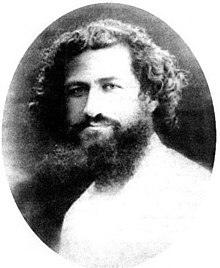Mirza Kutschak Khan
Mirza Kutschak (Kutschek) Khan ( Persian ميرزا كوچك خان; also Koutschek , Kutschak , Koutschak ; * 1880 in Rascht ; † December 2, 1921 in Ardabil Province , Iran ) was the leader of the forest movement - the Nehzat-e Dschangal ( Dschangali movement ) - from Gilan (northern Iran).
Life
Mirza Kutschak Khan, who was actually called Younes, was the son of Mirza Bozorg. Bozorg means in Persian as much as large , while kutschak the importance small has. The son of the great Mirza was consequently called the little Mirza (Mirza Kutschak). Born in Rasht in 1880 , he went to Koran schools in Rasht and later in Tehran. At the age of 25 he gave up his studies in theology, joined the constitutional movement and supported the constitutional revolution which led to the abolition of the absolutist monarchy in Iran, the introduction of a constitution based on Western models and the election of a parliament.
However, the newly created constitutional monarchy did not bring about a political reorientation of Iran, as many supporters of the constitutional movement had hoped. Inside, the aristocracy and the big landowners, and thus the old political elites, continued to hold power in their hands. Outwardly, the main dependence on Great Britain and Tsarist Russia continued . With like-minded people, Mirza founded his own independent movement in Gilan, the Nehzat-e Dschangal (forest movement), which published a magazine called Dschangal from 1917 to 1918 and, supported by communist Russia, proclaimed an Iranian Soviet Republic independent of the central government in Tehran in June 1920 .
On August 4, 1921, Kutschak Khan and Haidar Khan Amu Ogli were able to put to power. In order to avoid an offensive by Iranian government troops under Prime Minister Ahmad Qavam , he had Haidar Khan killed and offered his surrender on the condition that the province of Gilan would be granted autonomy . Prime Minister Qavam and Reza Khan , who were in command of the Cossack Brigade at the time , did not accept this offer and crushed the Jangali movement. Mirza Kutschak Khan was caught half frozen to death, brought to Rasht and beheaded on December 2, 1921 . His severed head was brought to Tehran as evidence of his death and handed over to Reza Khan on December 10, 1921. The writer Ebrahim Fakhrayi, a nephew and supporter of Mirza Kutschak Khan, brought the head of Kutschak Khan back to Rasht in the tomb of Kutschak Khan. Fakhrayi was buried next to Kutschak Khan after his death.
Literature (selection)
- Ebrahim Fakhrayi: Sardar-e Jangal (The Commander of the Jungle) . Tehran: Javidan, 1983.
- Gregor Yaghikiyan: Shooravi vā jonbesh e-jangal (The Soviet Union and the Jungle Movement ). Borzouyeh Dehgan, Tehran: Novin, 1984.
Individual evidence
- ↑ Cosroe Chaqueri: The Soviet Socialist Republic of Iran , 1995, p 363rd
| personal data | |
|---|---|
| SURNAME | Mirza Kutschak Khan |
| ALTERNATIVE NAMES | Koutschek; Kuchak; Kutschek; Koutschak |
| BRIEF DESCRIPTION | Iranian national hero |
| DATE OF BIRTH | 1880 |
| PLACE OF BIRTH | Rascht |
| DATE OF DEATH | December 2, 1921 |
| Place of death | Province Ardabil , Iran |
